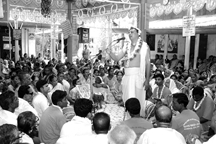Kirtan
Kirtan originated as a genre of Bangla songs in the form of worship by the Vaishvavas. The system of devotional songs in Bengal is very ancient. Usually the qualities of the deities and their deeds are described in kirtan.

Kirtan is of two kinds: namkirtan or namsangkirtan and lilakirtan or rasakirtan. Namkirtan refers to devotional songs in which the name of Hari or vishnu is repeated: ‘'Hare Krishva Hare Krishna Krishna Krishna Hare Hare/ Hare Rama Hare Rama Rama Rama Hare Hare’'. Lilakirtan or rasakirtan refers to narrative songs based on the stories of radha and krishna and the Gopis or milkmaids. The stories of Sri chaitanya and Gauranga, a Vaisnava ascetic, were included in lilakirtan. Some major lilakirtans are Gostha, Man, Mathur, Nauka Bilas, and Nimai Sannyas. Lilakirtan is also referred to as Padavali Kirtan.
gitagovindam of jaydev is the original source of kirtan songs. Other poets who contributed to kirtan include baru chandidas with srikrishnakirtan and vidaypati, a poet of Mithila, with his Vaishnava songs in brajabuli. Chaitanya considerably expanded the genre in the fifteenth century. Chaitanya realised that songs appealed to everyone irrespective of sex and age and that songs were the most effective medium to attract the illiterate. He believed that the easiest way to worship God was through songs rather than through reading religious texts.
Chaitanya turned kirtan into a social movement, using these songs to preach his ideas and ideals. He gave namkirtan a musical form and made it popular in Bengal.
After Chaitanya, lilakirtan developed in five streams, called after their places of origin: Gadanhati, Manoharshahi, Reneti, Mandarini and Jharkhandi. The gadanhati genre of kirtan was introduced by Narottam Das, a composer of songs from Garanhati Pargana in the district of rajshahi, in the sixteenth century. Narottam Das’s kirtans begin with verses praising Chaitanya, before going on to the main devotional theme. Narottam Das was an exponent of dhrupad as well. Accordingly, Gadanhati kirtan was known as Dhrupadabga kirtan. Jnandas Manohar, from Birbhum, introduced the Manoharsahi stream, which is influenced by Kheyalanga. The introducer of the Reneti stream was Bipradas Ghose, from Burdwan. This genre of kirtan was influenced by Tappabga. The Mandarini stream, which was introduced by Mandaran Sarkar, shows the influence of thungri. Jharkhandi kirtan originated in the Jharkhand area.
Narottam Das also introduced a new stream of kirtan known as Dhapkirtan, under the influence of tappa. Dhapkirtan songs begin with alap, after which the main theme is rendered in dhrupad. Padavali kirtan includes Udgraha, Melapaka, Dhruba and Abhog. According to Vaishnava scholars, there are 64 rasas (moods) in kirtan.
Generally kirtan is rendered in a standing position or combined with a dance. But there are also references to singers rendering kirtan while sitting.
Though kirtan belongs to the classical stream, it does not strictly follow the classical mode. One of the remarkable aspects of kirtan is that it uses the entire scale. Apart from the use of Todi, Kamod, Shrirag, Pahadi, and Patamavjuri ragas, other ancient ragas are also common.
There is great diversity in kirtan, which is rendered in three tempos: druta (fast), madya (medium), and bilambita (slow). Measures include Chhota Lofa, Bada Lofa, Rupak, Yati, Teot, Dothuki, Madhyam Dash Koshi, Bada Dash Koshi, Dashpede, Shashishekhar, and Vir Vikram.
Before the founding of Kolkata, kirtan was confined to the rural culture of Bengal. However, with the rise of Kolkata as a city in the early eighteenth century, kirtan and panchali became popular among the city people. Before 1947, both Hindus and Muslims enjoyed kirtan. kazi nazrul islam also wrote a number of highly acclaimed kirtan songs. Though looked upon with disfavour as a Hindu genre during the Pakistan colonial period, kirtan continued to be sung in the villages of East Pakistan. Though the performance of kirtan has lessened considerably, it is still very popular in the rural society particularly. The kirtan mode is also used occasionally for modern Bangla songs. [Khan Md Sayeed]
